A pre-war Scammell lorry that’s covered 1.2 million miles!
Posted by Chris Graham on 8th June 2023
Fewer than 2,000 Scammell lorries were manufactured between 1920 and WW2, but Zack Stiling tracks down a rare survivor and its lucky owner.
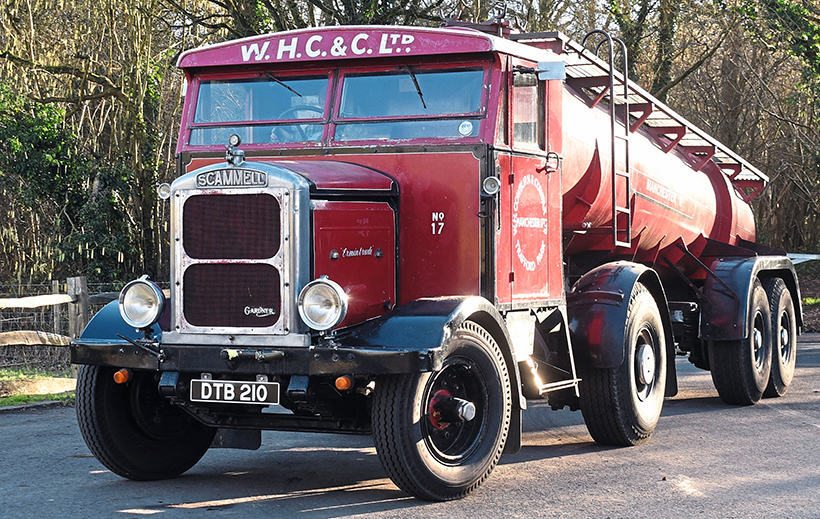
Scammell lorries: Scammell’s 4×2 motive units were its most popular product for 50 years.
Passions have a strange way of suddenly taking hold of people. Six years ago, the Johnson family – Adam, wife Camilla and son Ethan – had never had anything to do with old lorries, but now they own three Scammells, which they love. There’s no particular reason why it came to be so; Adam simply went to an auction one day and bought one on a whim, and so it began.

This rare survivor was originally used for transporting industrial acids.
There has been a historic family connection with lorries as Adam’s great-grandfather, Archer Johnson, established a haulage firm in Sydenham, south-east London. By the 1970s, A Johnson & Sons had a proud fleet of Bedford TKs and Kew-built Dodges, but Adam hasn’t been involved with haulage himself, instead working in farming and green waste recycling.
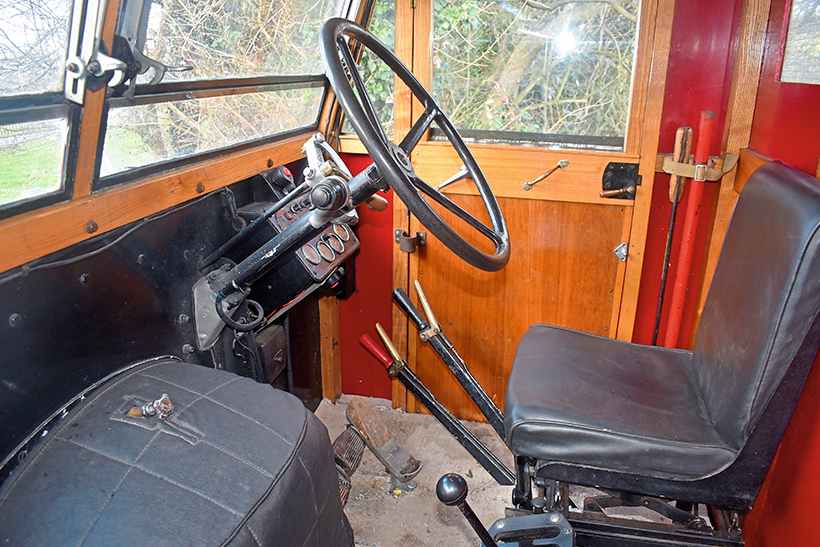
The cab is spartan, but not uncomfortable.
His first ‘old thing’ was a 1910 Crossley engine purchased about 20 years ago, but things escalated in 2017, when he bought a MkVI Bentley he’d been storing for somebody else. Then, in October 2018, he went to a Cheffins sale with the intention of buying an antique clock but, instead, came away with a 1952 Scammell MU (Motive Unit) in the livery of Cherry Blossom boot polish. Camilla had always liked the look of old, bonneted lorries and, as Adam confesses, “I bought one without telling her, knowing I could get away with it if it had a bonnet, and gave it to her as a wedding anniversary gift.”
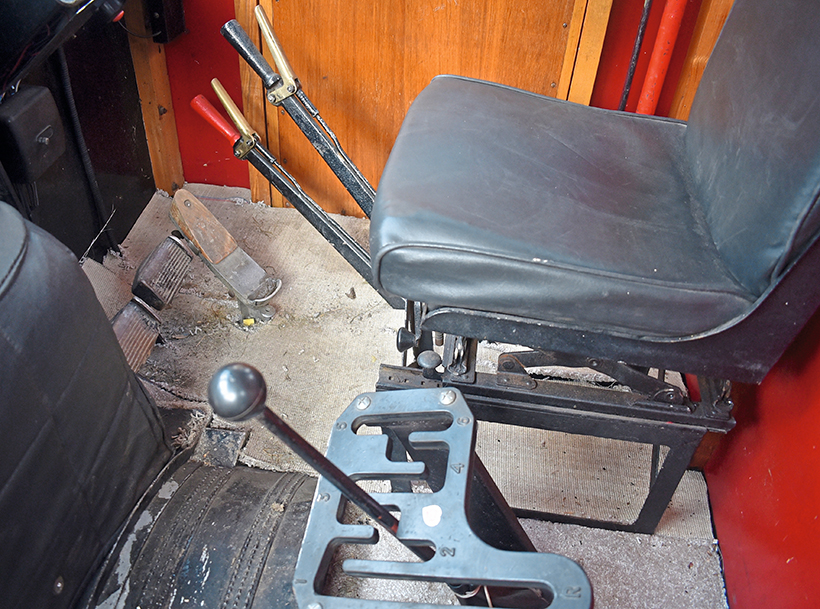
Everything in the cab, from the handbrake and gear lever to the pedals, feels huge.
It’s now been ‘stolen’ by our son,” Camilla added, referring to the fact that 26-year-old Ethan has spent the past two years driving it to shows and rallies all over the south-east. It was followed shortly afterwards by two further MUs, of 1938 and 1965 vintage. Since Scammells of pre-war manufacture are particularly rare, we’re especially interested in examining the ’38, now affectionately known as Ermintrude. It was bought by Adam when Cheffins auctioned the Roger Austin collection of Scammells in November 2021. He intended to bid on a flatbed trailer to tow behind Cherry Blossom, but he realised that the flatbed had originally belonged to the ’38 tanker and, says Adam, “I thought it was a shame to split them up, so I bought the lot.”
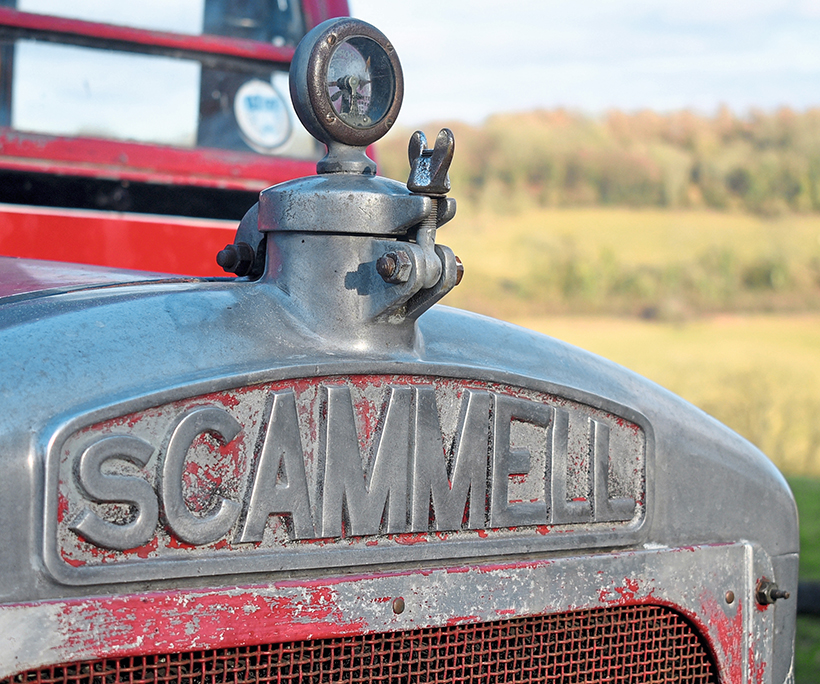
In the 40-plus years since the restoration, it has acquired a nice patina.
The Scammell was resplendent in the livery of WH Cowburn & Cowpar Ltd of Trafford Park, Manchester, with which it started its long and illustrious haulage career. For many years, Cowburn & Cowpar’s red, black and white livery would have been instantly recognisable in the Manchester area and, even though it no longer exists, the company continues to enjoy a certain renown among road and canal transport enthusiasts.
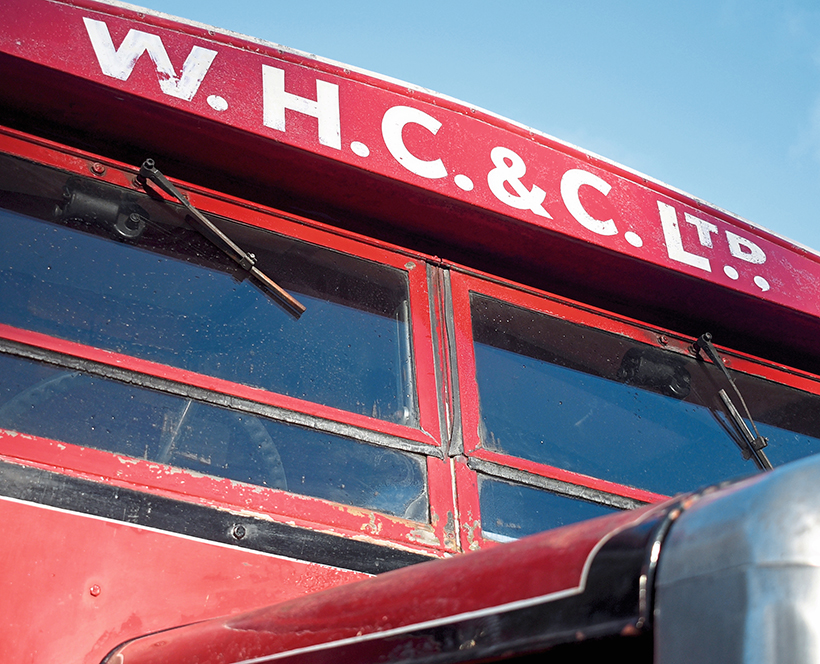
The distinctive livery was a familiar sight around Manchester, and on routes into Wales.
William Henry Cowburn (1848-1906) entered business as a chemical merchant for the Lancashire textiles industry in 1877, and founded the Cowpar Chemical Company with a Mr Parkin, in 1887, advertising ‘Spirits of Salts, Vitriol, and all solutions for dyers, printers and bleachers.’ It acquired premises at the Potato Wharf on Manchester’s Bridgewater Canal, and the enterprise grew steadily. From the late 1890s, it was heavily involved with producing chemicals for cotton manufacturer Samuel Courtauld. Arthur Cowburn took over his father’s firms in 1906 and, in 1916, they merged to become WH Cowburn & Cowpar Ltd.

The Scammell has been started on the handle, but it’s not a job for the faint-hearted!
Throughout this period, Cowburn & Cowpar transported its acids using narrowboats but, in the 1930s, it built up its fleet of over 20 articulated Scammells. All through the 1950s and ’60s they could be seen driving to and from the Courtaulds factories in Flint and Greenfield, in north Wales, and stopping for a fried breakfast at the Flint bus depot. But, after over 30 years of faithful service, most of the Scammells were sold for scrap in the 1970s. They had been gradually phased out from the late 1960s, when they were replaced by Fodens and Seddons. Cowburn & Cowpar was ultimately taken over in the late 1980s.
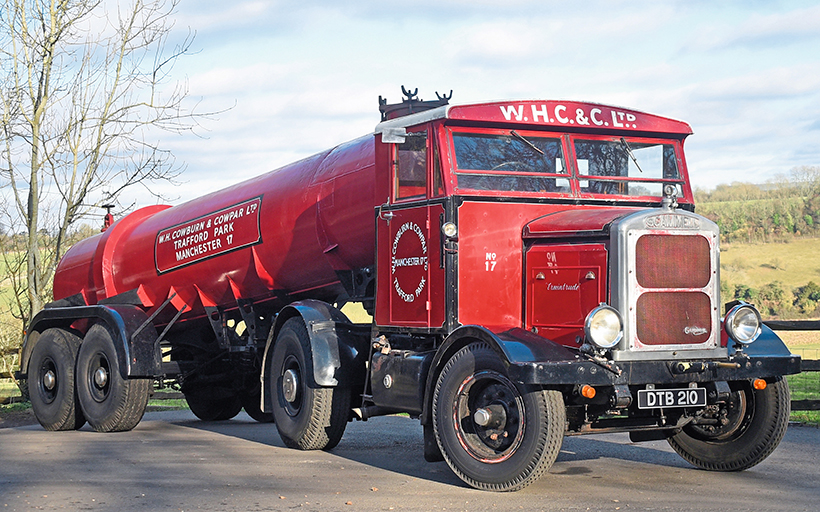
WH Cowburn & Cowpar was famous for its large fleet of Scammells.
There was a dark side to the business. The Scammells frequently transported carbon disulphide, which Courtaulds needed for the production of viscose. Exposure to CS2 was known to be severely detrimental to the health of its factory workers, but Courtaulds did everything it could to prevent such information being published.
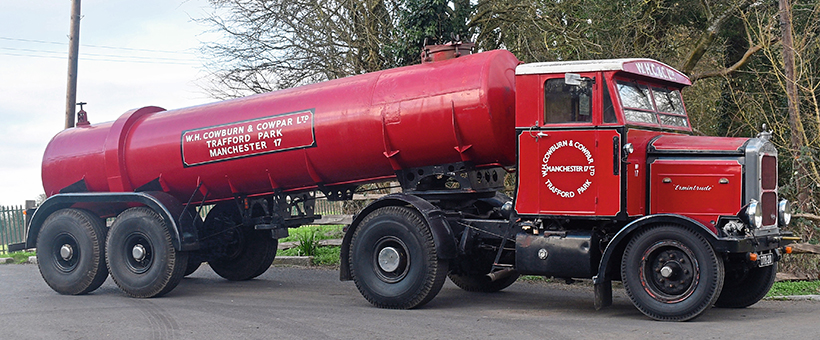
This MU had a 34-year service life during which it covered 1,260,000 miles.
DTB 210 was completed on April 30th, 1938, and registered on June 1st. It joined the Cowpar fleet as number 17, and it never had a moment’s rest. Its chassis number – 2405 – reveals it was the 1,705th Scammell built, since chassis-numbering started at 700 in 1922. It was in use all through the war, and remained in service until September 30th, 1972, by which point it had covered a grand total of 1,260,000 miles. In the words of Truck & Driver, Cowburn & Cowpar ‘was not a firm to suffer inefficient vehicles lightly’.
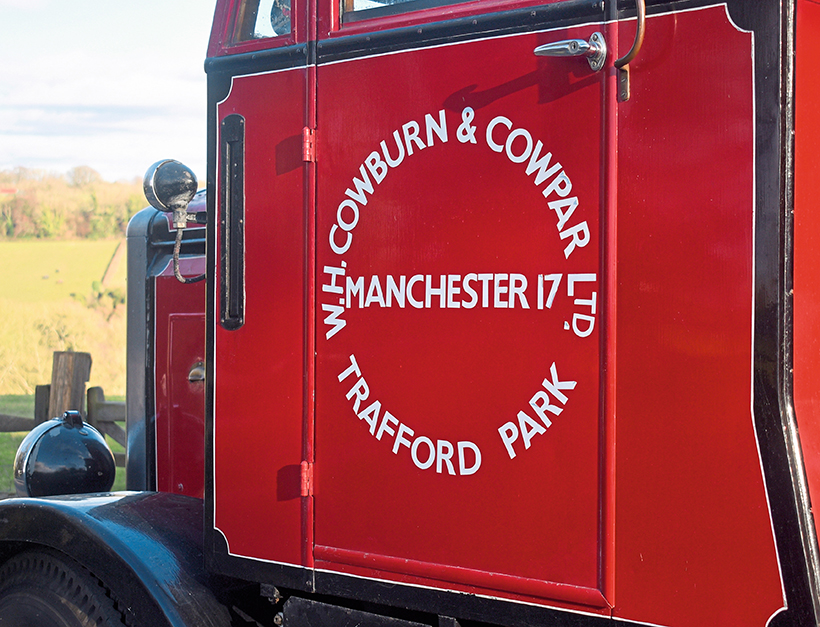
Cowburn & Cowpar operated Scammells until the 1970s.
Fleet No. 17 was a rather special lorry because, in addition to the tanker trailer which it had in common with most of the fleet, Cowburn & Cowpar additionally ordered it with a matching flatbed. This was for the transportation of carboys – large glass jars full of acid – that were carried in metal mesh baskets padded with straw. Twice a year, in those carefree days before health and safety became a problem, the flatbed would also be used for taking employees’ children on a trip to the seaside.

The diesel tank will hold a full 30 gallons.
A detailed maintenance record was kept and still survives, so we know about each and every job that was undertaken between 1951 and 1972. No. 17 had two engine changes during its working life; the first in 1955 after 361,195 miles and the second in 1963, after about 730,000 miles. At the time of the second change, there doesn’t appear to have been anything wrong with the engine as the maintenance sheet notes that it was removed to be refitted in a No. 1 generator.
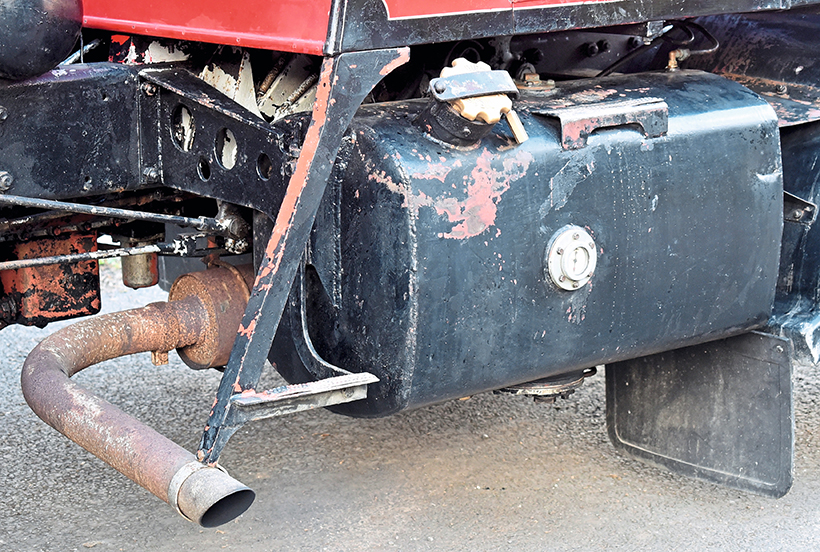
In earlier lorries, the fuel tank would have been located inside the cab.
To some people, perhaps, the most memorable Scammells were those which fulfilled the most specialised applications – gaily-belight Showtracs, Pioneers pulling heavy artillery and Constructors crossing inhospitable terrain in the search for oil – but it was the straightforward motive units on which Scammell really depended, and which accounted for the bulk of production.
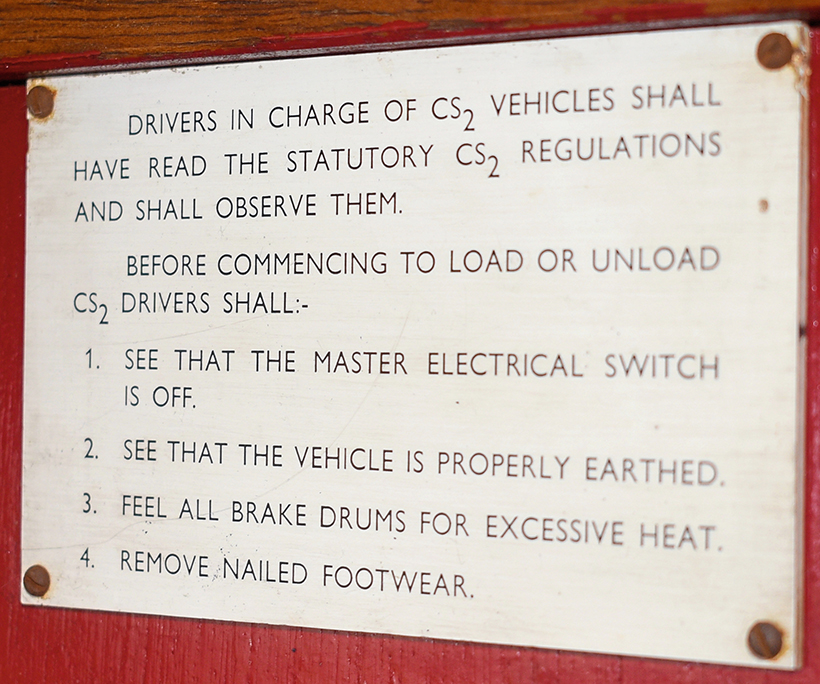
An operational safety plaque reveals that No. 17 would have been used for transporting carbon disulphide.
Following the Great War, there was increasing commercial interest in articulated lorries, and cart-maker George Scammell & Nephew of Spitalfields was approached by a customer to build a vehicle along the lines of the American Knox. So it was that between 1919 and 1920, the first motorised Scammell was built, an articulated six-wheeler, and so well did it perform that Scammell Lorries Ltd was established as a separate company in 1922, using a new factory on Tolpits Lane, in Watford.
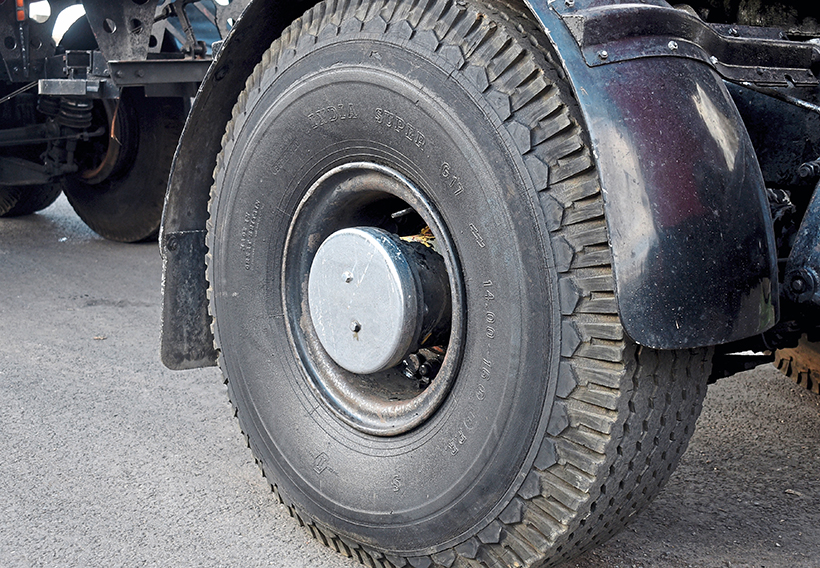
The wheels are attractively patinated.
At the 1921 Olympia Motor Show, Scammell exhibited a 2,000-gallon fuel tanker built for Shell-Mex, entirely designed and manufactured by Scammell and believed to be the first instance of a British-made articulated tanker. Within a few years, Scammell had developed its first frameless tanker, and its articulated tractor-tankers would come to account for a very large percentage of Scammell’s sales in Britain. So it’s no surprise that Cowburn & Cowpar turned to Watford when it sought a dependable and well-reputed means of transporting its acids by road. Demand was ever on the rise and, in 1940, Scammell opened a new factory at Moor Park, exclusively for the manufacture of semi-trailers.
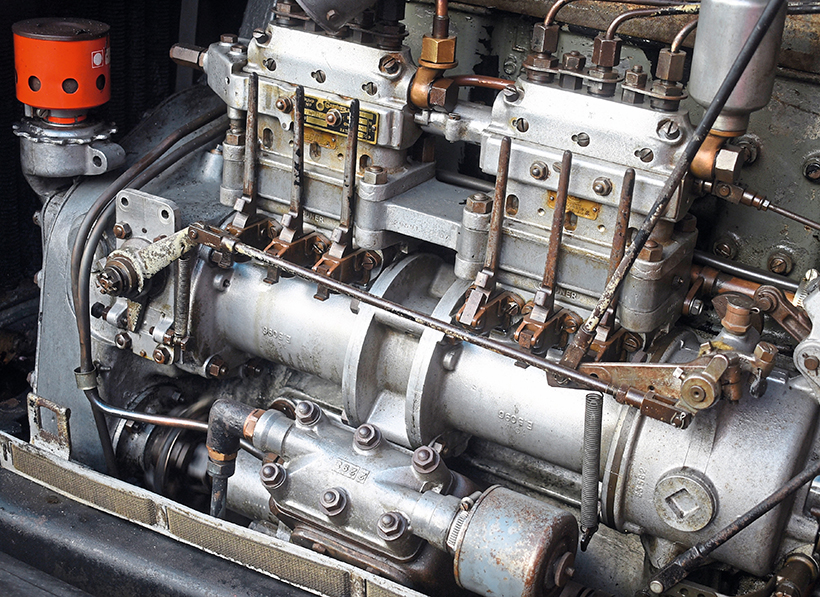
Motive units from the 1930s relied on Gardner’s trusty diesel engines.
Motive units on 4×2 chassis were Scammell’s mainstay from its very beginning in 1920 all the way up to 1970; a 50-year span which saw minimal changes. When Gardner diesels became available in the early 1930s, Watford started using the 112hp, 8,370cc 6LW and the 150hp, 10,450cc 6LX – both six-cylinders. Leyland engines were offered from 1955, when the MU was given a model name for the first time – Highwayman – but the Gardner engines would remain optional until the end of MU production.
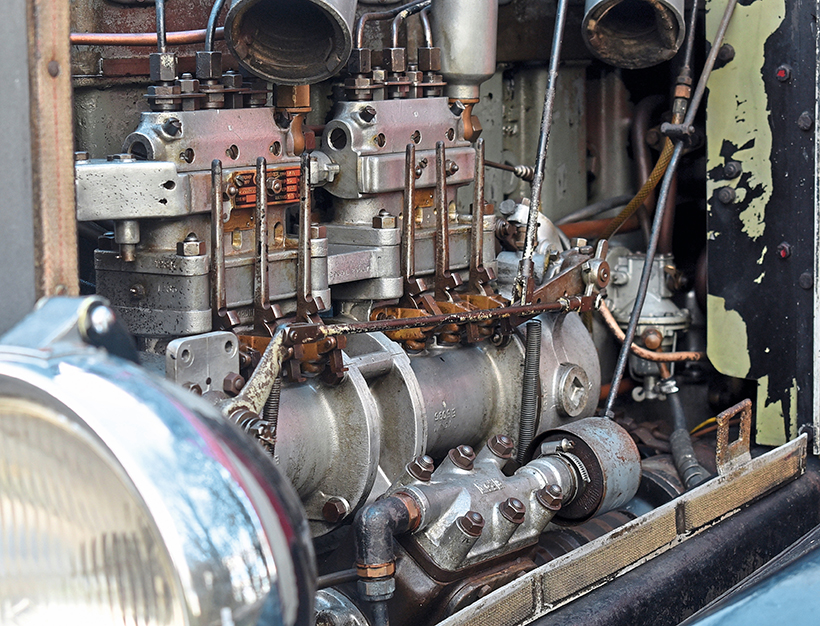
No. 17 is fitted with a version of the 6LW engine.
When No. 17 was withdrawn from service in 1972, it had apparently run an engine bearing. Its maintenance entry reads: ‘chassis and engine to S Unsworth Esq as scrap.’ Fortunately, Sid Unsworth was not a scrapman but a retired inspector with Lancashire Police, not to mention an enthusiast. He is to be thanked for saving No. 17, restoring it and introducing it to the preservation circuit.
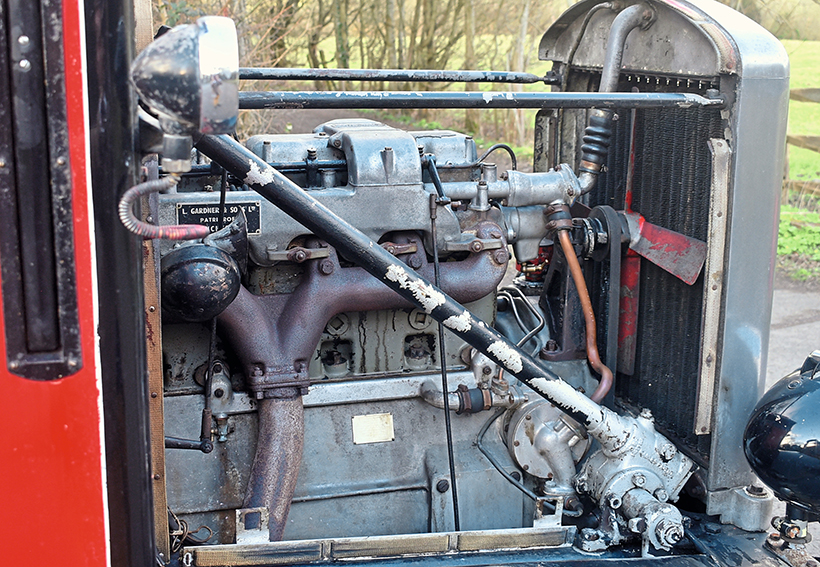
It has a capacity of 8,370cc and produces 112hp.
The restoration must have taken a few years, but it progressed quickly enough for No. 17 to be entered in the 1981 North Cheshire Cavalcade of Commercial Vehicles, and the 1984 Trans-Pennine Run, where it earned itself a place on the front cover of The Vintage Commercial Vehicle Magazine.
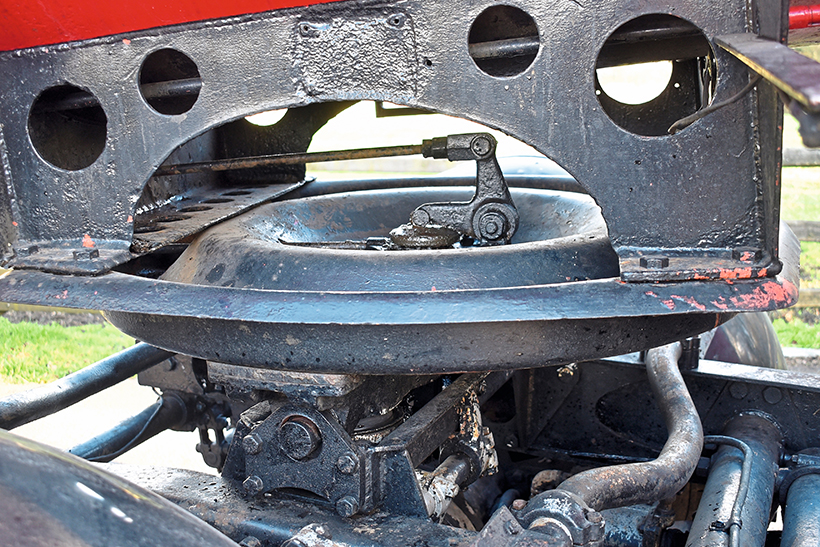
The trailer was of Scammell’s own design, as was the coupling.
Sid Unsworth owned it for about 15 years but, by 1988 he’d sold it to Roger Austin, who was only then beginning to amass his vast collection. In fact, it was only his second Scammell, and the first to be consciously bought with the intention of collecting, as many owners seemed to believe his ‘wanted’ advertisements were the work of a dealer. In Austin’s ownership, it continued to be rallied, and appeared very briefly in a 1990s advertisement for the Ford Mondeo, wearing horror make-up reminiscent of the Peterbilt in the film Duel. This led to some further restoration, as the supposedly harmless film paint took the lacquer off the paint underneath.

Adam Johnson is greatly enjoying Scammell ownership.
Roger Austin died in 2005, but the collection was retained by his family until the sale in 2021. Impressively for a vehicle which had been unused for at least 16 years, it needed only the lightest recommissioning when Adam Johnson came to put it back on the road. As he explains, “I drove it to the Centenary and the brakes were terrible, so I was working overnight before the Brighton Run to fix them. I hadn’t driven it much when I drove it to Watford for the Centenary through the middle of London. On the way back from the Brighton Run we started getting fuel problems. We found the fuel system was blocked up with old diesel which had just been sitting, so we had to take it all apart.”

A period photograph of Cowburn & Cowpar’s No. 19.
Apart from a small hole in the radiator which Adam is still to fix, it didn’t really take anything else to get No. 17 back to the same condition in which Unsworth and Austin had been proud to show it off. While various new Scammell models with different functions were introduced in the post-war years, the MUs changed very little. Despite Ermintrude being Adam’s oldest, he says it’s the best one to drive, being much lighter than its younger stablemates.
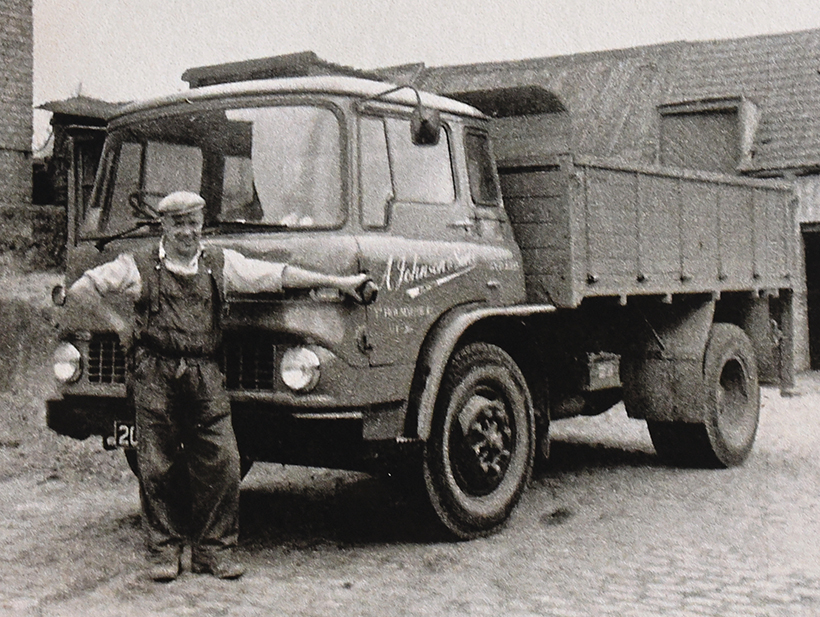
An attractive Bedford TK in the original livery of A Johnson & Sons.
“Everyone who drives it says it’s really nice,” he affirms. “It’s not very quick but the brakes are perfect. Although it hasn’t got power-steering, it’s very light when you’re on the move. When you’ve got used to the crash gearbox, it’s very easy, but I wouldn’t want to spend a whole day driving it. It also backs up and turns around very easily. I would think with a full load, it would be very slow and hard work up the hills, but going to shows is an easy and pleasurable thing to do.”
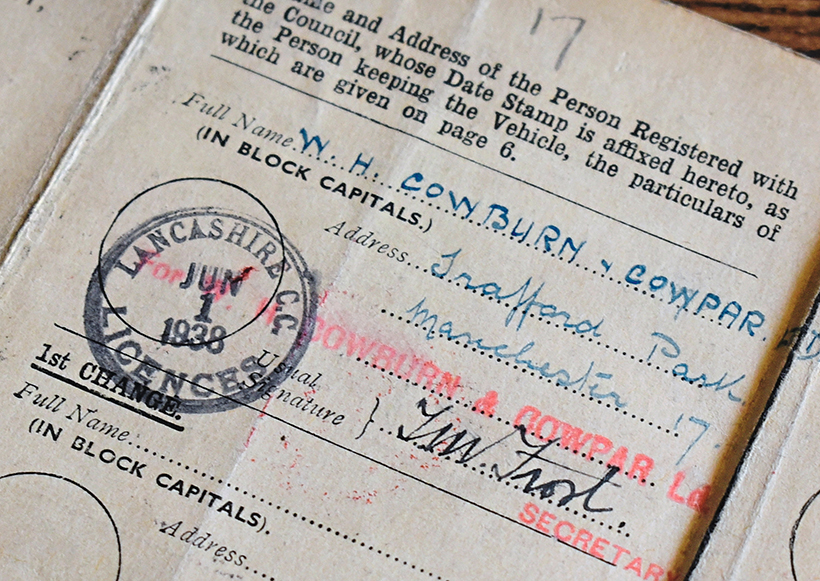
The buff logbook confirms No. 17’s provenance.
Speed, of course, is relative, and it feels quite fast trundling along the narrow country lanes near Adam’s home, but it’s easy to see how one’s perception may differ when spending 10 hours travelling up and down Britain’s trunk roads. In any case, it represents a considerable improvement over the 18mph achieved by the first Scammell, which was 6mph in excess of the legal limit of 1920, anyway.

One of the family’s Dodges unloading rubbish at the yard in Sydenham.
It can be seen from Adam’s confident and relaxed driving that No. 17 is, indeed, a light and easily-controllable vehicle which, despite appearing large, doesn’t take up too much space on the road. Even so, one’s sense of scale is magnified when inside the cab which, being a two-seater, has lots of room to spare. The enormous gear-change gate fills the space in the centre where, in later lorries, a third seat would be found, and everything else – from the handbrake lever to the pedals – gives the impression of great size. The fact that the cab is sparsely stocked with only the most basic instruments contributes to the sense of spaciousness and scale.
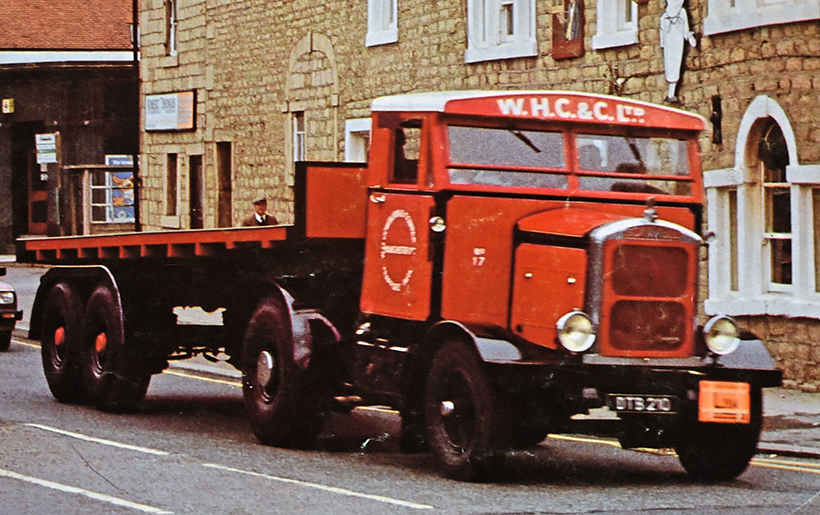
No. 17 pictured pulling its flatbed trailer on the 1984 Trans-Pennine Run.
The Johnsons may be relative newcomers to the preservation scene, but they’re as enthusiastic as many who have been involved for years and years. Since Adam and Ethan both enjoy every second spent behind the wheel of their Scammells, it looks like they’ll be regulars on the rally scene for the foreseeable future. Meanwhile, at home, there might just be space for one or two extra vehicles…
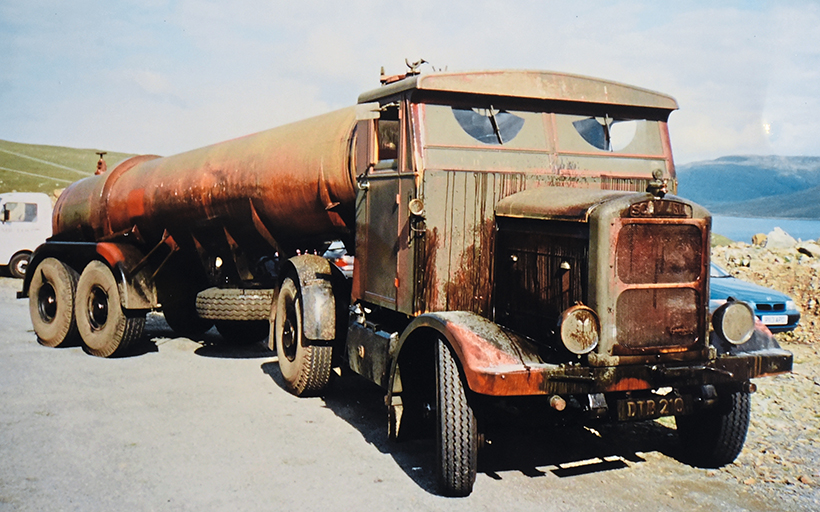
While with Roger Austin, the Scammell was dressed up for a Ford Mondeo commercial.
This feature comes from a recent issue of Old Glory, and you can get a money-saving subscription to this magazine simply by clicking HERE
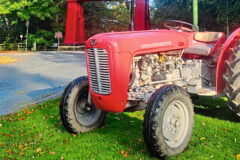
Previous Post
New club for tractor, engine and agricultural machinery enthusiasts

Next Post
The world’s largest motor graders!



